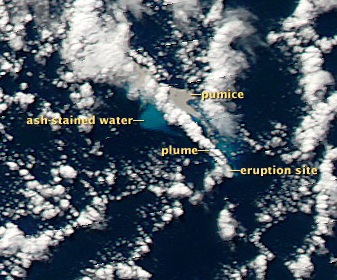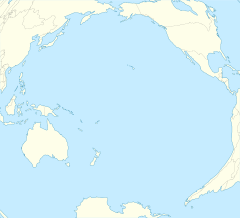Havre Seamount facts for kids
Quick facts for kids Havre Seamount |
|
|---|---|

Satellite image of 2012 eruption
|
|
| Summit depth | 720 m (2,400 ft) |
| Height | 1,030 m (3,400 ft) |
| Location | |
| Location | South Pacific Ocean |
| Group | Kermadec Islands |
| Coordinates | 31°06′00″S 179°02′00″W / 31.10000°S 179.03333°W |
| Country | New Zealand |
| Geology | |
| Type | Volcano |
| Last eruption | July 2012 |
Havre Seamount is an active underwater volcano, also known as a seamount. It is located deep in the Pacific Ocean, near the Kermadec Islands of New Zealand. This amazing volcano is part of a long chain called the Tonga-Kermadec Ridge. Its last big eruption happened in July 2012.
Contents
What is Havre Seamount?
Havre Seamount is a giant underwater mountain. It was formed by volcanic activity over many years. This seamount is part of a long chain of volcanoes. This chain stretches across the ocean floor.
Where is Havre Seamount Located?
Havre Seamount is found in the southwest Pacific Ocean. It is part of the Kermadec Islands group. These islands belong to New Zealand. The seamount sits on the Tonga-Kermadec Ridge. This ridge is a very active area.
How Big is Havre Seamount?
This underwater volcano is quite large. Its top is about 720 meters (2,360 feet) below the ocean's surface. From its base, it rises about 1,030 meters (3,380 feet) tall. That's taller than many famous buildings!
Understanding Seamounts and Volcanoes
A seamount is an underwater mountain. It rises from the ocean floor but does not reach the surface. Most seamounts are formed by volcanic activity. They are often found in chains or groups.
How Do Underwater Volcanoes Work?
Underwater volcanoes erupt much like land volcanoes. Magma, which is hot melted rock, pushes up from inside the Earth. When it reaches the ocean floor, it erupts. This eruption can create new rock. Over time, this builds up into a seamount.
Why Are Seamounts Important?
Seamounts are important for ocean life. They create unique habitats for many sea creatures. Fish, corals, and other animals gather around them. This is because seamounts often bring up nutrient-rich water.
The 2012 Eruption of Havre Seamount
Havre Seamount had a major eruption in July 2012. This event was quite a surprise. It was one of the largest underwater eruptions ever recorded. Scientists learned a lot from it.
Discovery of the Eruption
The eruption was not seen directly at first. Instead, a large raft of pumice was spotted floating in the ocean. Pumice is a light, bubbly volcanic rock. This raft was huge, covering a vast area. It was bigger than the country of Belgium!
What Happened During the Eruption?
The eruption sent ash, gas, and pumice into the water. The pumice floated to the surface. This created the massive pumice raft. The eruption also changed the shape of the seamount's top. It created a new caldera, which is a large crater.
Impact of the Pumice Raft
The giant pumice raft drifted across the Pacific Ocean. It traveled thousands of kilometers. Many marine organisms, like barnacles, attached to the pumice. This helped them travel long distances. The raft eventually broke apart and sank.
Studying Havre Seamount Today
Scientists are still studying Havre Seamount. They use special underwater robots and ships. These tools help them explore the volcano. They want to understand how it works. They also want to learn about the life around it.
Future of Havre Seamount
Havre Seamount is an active volcano. This means it could erupt again in the future. Scientists continue to monitor it. This helps them predict future activity. It also helps them understand ocean geology better.


